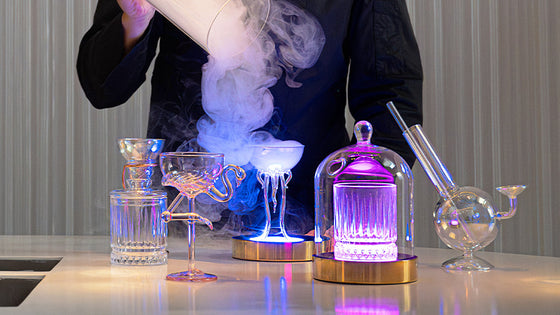Why Tokyo has been called the “Cocktail Capital of the World.”
There’s plenty of amazing bars, great ingredients and a long established history to get out teeth into. So let’s start with how it all began (cue flashback sequence)…

The first cocktail book ever written came out of the American 'Golden Age' of cocktail invention in 1862. Less than ten years later, Japan's first cocktail bar opened: Yokohama's International Hotel opened in 1874. So how did this drinking style spread so far in just a decade?
America’s Golden Age Coincides with Japan’s Meiji Restoration
In 1853, Commodore Matthew C Perry arrived in Japan's Yokohama port with a fleet of large gunships to negotiate a trade treaty. The technology and armaments shook the feudal island's inhabitants and provoked the Meiji Restoration in 1868. A political power grab by Shishi rebels who convinced Emperor Meiji to take the Character Oath — an oath outlining the legal constitutions for a new society and constitutional monarchy — totally reimagining Japan's political and social structure. Meiji looked to Western cultures for inspiration for industrial reform. Before he came to power, Japan had spent centuries in imposed isolation, and after they welcomed American technology and trade, including American serving styles, spirits and beer.
The first bar to thrive was a wild west style tavern called the Yokohama Hotel, or Hotel Hufnagel (after its Dutch owner), during the 1860s, where bartenders poured everything straight up, and a clientele whose drinking games included firing their pistols at a clock on the bar's wall. It took just a decade to go from that to the upper-class International Hotel in 1874, and another six to reach Tokyo, with the Kamiya Bar opening in 1880.
But it wasn't until the arrival of Louis Eppinger in the 1890s that cocktail culture took off on Japan's own terms. Eppinger worked at the Grand Hotel, also in Yokohama, and is credited with introducing cocktails like the Bamboo and Million Dollar to Japanese drinkers. He had a team of locals who served as apprentices who eventually spread across the country and developed their unique style of service.

While America went into Prohibition, putting a pause to the quality cocktail era, the Japanese hit their stride. The Taishō era, from 1912 to 1926, saw the rise in individual equity, international trade and liberalism that propelled the urban Japanese into a party era of cocktail indulgence. They congregated in Tokyo's Ginza neighbourhood and enjoyed European-style cafe's like Maison Konosu, Cafe Printemps and Cafe Lion.
In 1926, the Japanese cocktail book containing detailed recipes of classic mixed drinks with western style measurements was published. Titled Kokuteeru, after an old slang word for a pick-me-up, it was published by bartender Yonekichi Maeda, a 27-year-old bartender at the Yotsuya-based bar Cafe Line.
Developing National Classicism
After the Second World War followed years of deprivation and chaos. The occupation of Japan by the Allied Powers started in August 1945 didn't end until April 1952, and the Ryukyu Islands weren't returned from American rule until 1972. There was a severe shortage of food. A new constitution went into effect in 1947: the Emperor lost all political and military power and became only a state symbol. Shinto, Japan's indigenous faith, was separated from the state too. American General Douglas MacArthur was given authority over the Government and set about censoring the media, dissolving large companies, decentralising the police and education system and breaking up land monopolies. Alcohol production became lawless again; Kasutori Shōchū, or The Dregs, became a popular black market beverage. It wasn't until their emancipation in the 50s that the Japanese economy began to recover.
Kotobukiya Co, (Suntory) was founded in 1899 by Shinjirō Torii. He founded the Yamasaki distillery in 1923 but had to halt production during the war. In 1946 it re-released Tory’s Whisky. In 1950, Tory's Bar opened in Ikebukuro, Tokyo. Within a decade, Tory's were on every city street corner, serving up Suntory-made whiskey, gin, rum and fortified wine. The drinks were good but aimed at the average income bracket, so by the time economic success rolled around again, in the early 70s, high-end venues needed to differentiate themselves.
So, they developed a distinctly Japanese style of cocktail classicism. For example, they introduced the Japanese-style culinary apprenticeships. With young skippers asked to wash glassware and restock back bars, just watching and waiting with little further instruction for more than two or three years, before they were allowed even to touch the barware. They focused on service values, developing particular methods in drink preparation that were based on attention to detail, with emphasis on the process of service rather than the result, delivered with the panache but solemnity of the traditional tea rituals.
Even with straightforward mixed drinks, like the Whisky Highball, every inch of the making process was scrutinised and improved. Hand-carved ice, crystal cut stirring glasses, drop and dash bottle toppers, all borrowed from the original American influences, went back into vogue. Masaaki Wada, at Hamayu, in Niigata, came up with the ice ball, a dimpled sphere of ice designed to last longer in the glass. A technique further developed by subsequent bartenders into the diamond-cut ice we see today.
Also Read: Japanese Classic Cocktails
They developed a style of poses and stances, a theory borrowed from martial arts, to carry each movement of service so that the delivery of a drink is a considered physical feat. This affected the shape and format of the bar arrangement and set-up and the presentation of the cocktail. It resulted in the invention of the Japanese hard shake. A technique using a three-piece cobbler shaker that Kazuo Uyeda has spent his career perfecting. The results are mesmerising, and where American bartending has moved into the realms of speed and spectacular, the Japanese style remains subtle and individualistic.
Now modern bartenders are looking to the future. With new operations like 0% in Tokyo serving up non-alcoholic cocktails (using the Flavour Blaster kit, we might add), and bartenders like Shingo Gokan beginning to develop their own range of products, there is a horizon of change in Japan.
















